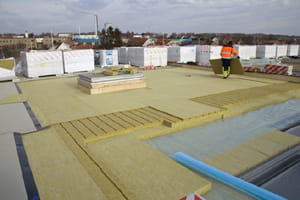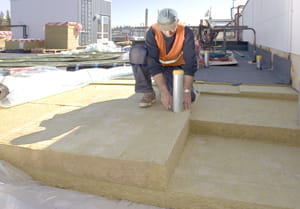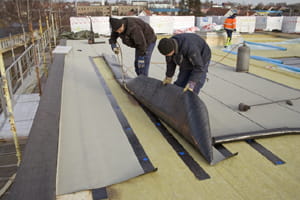Remove all water, snow or waste from the supporting structure before installing a water barrier or insulation slabs. The supporting structure has to be smooth and even.
Handling, storing and packing
Paroc delivers boards and slabs on disposable wooden pallets or stone wool supports that are intended to be handled using forklift trucks. The pallets require an even foundation. The packaging consists of stretch film that allows pallets to be stored outdoors without additional covering. Cover opened packages from the rain and wind.
Pallet placement on the roof
Roof insulation pallets are usually quite heavy (500– 600 kg), so locate them on the roof in a way that avoids damaging the supporting structure. Select a location for the pallets so that they don`t have to be moved during installation. If you transfer pallets, use a forklift with a special lifting fork or lifting slings. Avoid storing pallets on the insulated roof.
Installation
|
Install insulation carefully. No gaps between the slabs or insulation layers are allowed. Avoid connecting four slab corners. Stagger the joint of the Insulation layers. For two-layer insulation, install the second layer immediately after the first one. For grooved insulations (Paroc Air), follow the separate roof plan for installation.
|
 |
|
Install the waterproofing layer immediately after installing the insulation or cover the insulated area temporarily during the night. Moisture from the installation phase dries fast due to the open structure of stone wool insulation. Grooved insulation slabs secure fast drying.
|
 |
Move insulation slabs on the roof with rubber-tyred trolleys. One person can handle slabs alone. Use a handsaw or knife to cut the insulation slabs. To make holes, use a knife.
To lay the roof slope and drainage groove wedges, follow the diagrams that accompany the slabs or our brochures.
Restrict the amount of pedestrian traffic on the insulation while you are laying it. Where there is frequent pedestrian traffic, put down gangplanks, either permanently or just during installation.
Mechanical fasteners
|
Due to wind suction load and other structural forces in the roof structure, mechanically fix the roof membrane and insulation layers to the supporting structure. If necessary, mount thermal insulation with separate fasteners to avoid insulation movement during the installation phase. Mechanical fasteners have to be corrosion-resistant and flexible.
|
 |